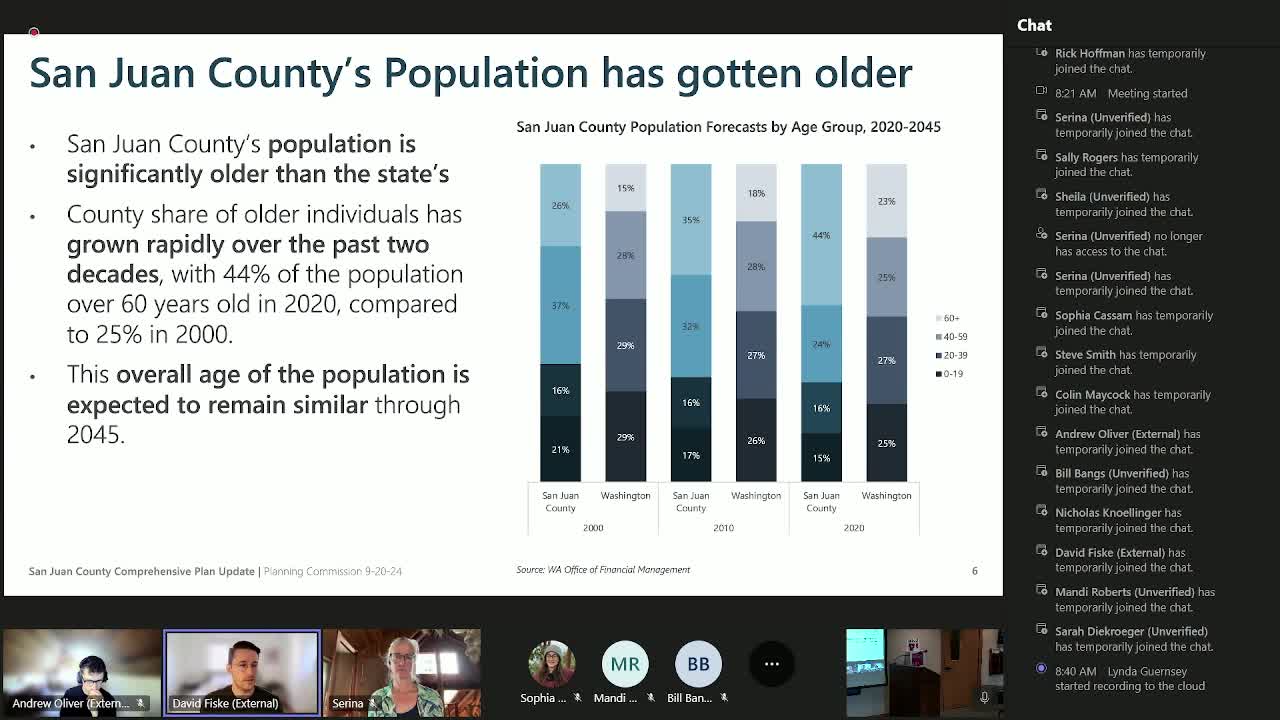San Juan County faces housing crisis amid aging population
September 20, 2024 | San Juan County, Washington
This article was created by AI summarizing key points discussed. AI makes mistakes, so for full details and context, please refer to the video of the full meeting. Please report any errors so we can fix them. Report an error »

San Juan County is experiencing significant demographic shifts, with an aging population, increasing diversity, and rising wealth levels, according to recent findings presented at a government meeting. The county's population has grown older, with individuals over 60 years old now comprising 44% of residents, up from 26% in 2000. This trend is expected to stabilize over the next two decades. Additionally, the county has become more racially and ethnically diverse, particularly with a notable increase in the Hispanic and Latino populations.
The educational attainment in San Juan County is also on the rise, with 52% of residents holding a bachelor's degree or higher, compared to 38% statewide. This highly educated demographic is accompanied by a surge in wealthier households, as evidenced by a twofold increase in the share of households earning $150,000 or more annually since 2012. However, despite this wealth, approximately 12% of the population lives below the federal poverty line, and 27% earn too little to meet basic household needs.
Employment participation has declined, with 47% of the population of working age not in the labor force, largely due to an influx of retirees. Income sources have shifted, with property-based income and transfer payments, such as Social Security and pensions, accounting for half of the county's total income. Remote work has also increased, particularly in higher-paying sectors like information technology and finance.
Housing affordability remains a pressing issue, with 40% of households classified as low income. Nearly two-thirds of renters fall into this category, and 33% of all households are considered cost-burdened, spending more than 30% of their income on housing. The median home price in San Juan County has nearly reached $1 million, having doubled since 2016, while wages have not kept pace with rising housing costs.
The county's housing inventory has not kept up with population growth, with a significant slowdown in new housing production over the past decade. Currently, 38% of housing units are vacant, a figure that includes seasonal and vacation homes, which limits the availability of permanent housing for residents. The meeting underscored the urgent need for strategic planning to address these housing challenges and ensure that the needs of all residents are met.
The educational attainment in San Juan County is also on the rise, with 52% of residents holding a bachelor's degree or higher, compared to 38% statewide. This highly educated demographic is accompanied by a surge in wealthier households, as evidenced by a twofold increase in the share of households earning $150,000 or more annually since 2012. However, despite this wealth, approximately 12% of the population lives below the federal poverty line, and 27% earn too little to meet basic household needs.
Employment participation has declined, with 47% of the population of working age not in the labor force, largely due to an influx of retirees. Income sources have shifted, with property-based income and transfer payments, such as Social Security and pensions, accounting for half of the county's total income. Remote work has also increased, particularly in higher-paying sectors like information technology and finance.
Housing affordability remains a pressing issue, with 40% of households classified as low income. Nearly two-thirds of renters fall into this category, and 33% of all households are considered cost-burdened, spending more than 30% of their income on housing. The median home price in San Juan County has nearly reached $1 million, having doubled since 2016, while wages have not kept pace with rising housing costs.
The county's housing inventory has not kept up with population growth, with a significant slowdown in new housing production over the past decade. Currently, 38% of housing units are vacant, a figure that includes seasonal and vacation homes, which limits the availability of permanent housing for residents. The meeting underscored the urgent need for strategic planning to address these housing challenges and ensure that the needs of all residents are met.
View full meeting
This article is based on a recent meeting—watch the full video and explore the complete transcript for deeper insights into the discussion.
View full meeting
